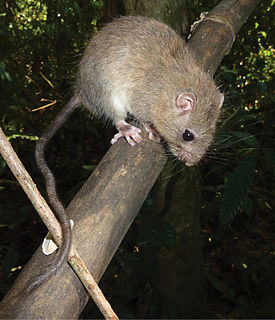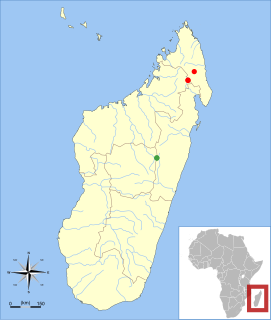
Lundomys molitor, also known as Lund's amphibious rat or the greater marsh rat, is a semiaquatic rat species from southeastern South America.

Pseudoryzomys simplex, also known as the Brazilian false rice rat or false oryzomys, is a species of rodent in the family Cricetidae from south-central South America. It is found in lowland palm savanna and thorn scrub habitats. It is a medium-sized species, weighing about 50 grams (1.8 oz), with gray–brown fur, long and narrow hindfeet, and a tail that is about as long as the head and body. The IUCN has assessed its conservation status as being of least concern, although almost nothing is known about its diet or reproduction.
The Shansei vole is a species of rodent in the family Cricetidae. It is found only in north-central China where its habitat is forests.

Delacour's marmoset rat, also known as the lesser marmoset rat, is an arboreal species of rodent in the family Muridae. It is found in China, Laos, and Vietnam. Its natural habitat is montane subtropical or tropical dry forest at elevations from 1200 to 1500 m. It is threatened by habitat loss.

Hapalomys is a genus of rodent in the family Muridae endemic to Southeast Asia. It is the only member of the tribe Hapalomyini. It contains the following species:
The marmoset rat, also known as the greater marmoset rat, is a species of rodent in the family Muridae. It is found in Malaysia, Myanmar, and Thailand. Its natural habitat is subtropical or tropical dry forests. It is threatened by habitat loss.

Eremoryzomys polius, also known as the gray rice rat or the Marañon oryzomys, is a rodent species in the tribe Oryzomyini of the family Cricetidae. Discovered in 1912 and first described in 1913 by Wilfred Osgood, it was originally placed in Oryzomys and named Oryzomys polius. In 2006, a cladistic analysis found that it was not closely related to Oryzomys in the strict sense or to any other oryzomyine then known, so that it is now placed in its own genus, Eremoryzomys. The Brazilian genus Drymoreomys, named in 2011, is probably the closest relative of Eremoryzomys. Eremoryzomys has a limited distribution in the dry upper valley of the Marañón River in central Peru, but may yet contain more than one species.
German's one-toothed moss mouse is a species of rodent in the family Muridae which occurs in the mountains of southeastern New Guinea.

Noronhomys vespuccii, also known as Vespucci's rodent, is an extinct rat species from the islands of Fernando de Noronha off northeastern Brazil. Italian explorer Amerigo Vespucci may have seen it on a visit to Fernando de Noronha in 1503, but it subsequently became extinct, perhaps because of the exotic rats and mice introduced by the first explorers of the island. Numerous but fragmentary fossil remains of the animal, of uncertain but probably Holocene age, were discovered in 1973 and described in 1999.

Thomasomys ucucha, also known as the ucucha thomasomys, is a rodent in the genus Thomasomys of the family Cricetidae. It is known only from high altitude forest and grassland habitats in the Cordillera Oriental of Ecuador. Seven other species of Thomasomys live in the same areas. First collected in 1903, T. ucucha was formally described as a new species in 2003 and most closely resembles T. hylophilus, which occurs further to the north. The species is listed as "vulnerable" in the IUCN Red List as a result of habitat destruction.
Reigomys primigenus is an extinct oryzomyine rodent known from Pleistocene deposits in Tarija Department, southeastern Bolivia. It is known from a number of isolated jaws and molars which show that its molars were almost identical to those of the living Lundomys. On the other hand, the animal possesses a number of derived traits of the palate which document a closer relationship to living Holochilus, the genus of South American marsh rats, and for this reason it was placed in the genus Holochilus when it was first described in 1996. The subsequent discoveries of Noronhomys and Carletonomys, which may be more closely related to extant Holochilus than H. primigenus is, have cast its placement in Holochilus into doubt, and it was ultimately made the type species of a separate genus, Reigomys.

Oecomys sydandersoni is an arboreal species of rodent in the genus Oecomys. It lives in forest patches in a small area in eastern Bolivia. It is a medium-sized species, weighing about 45 g (1.6 oz), with mostly grayish and brownish fur and short and broad hindfeet with well-developed pads.

In rodent anatomy, the zygomatic plate is a bony plate derived from the flattened front part of the zygomatic arch (cheekbone). At the back, it connects to the front (maxillary) root of the zygomatic arch, and at the top it is connected to the rest of the skull via the antorbital bridge. It is part of the maxillary bone, or upper jaw, which also contains the upper cheekteeth. Primitively, rodents have a nearly horizontal zygomatic plate. In association with specializations in zygomasseteric system, several distinct morphologies have developed across the order.

Voalavo is a genus of rodent in the subfamily Nesomyinae, found only in Madagascar. Two species are known, both of which occur in mountain forest above 1250 m (4100 ft) altitude; the northern voalavo lives in northern Madagascar and eastern voalavo is restricted to a small area in the central part of the island. The genus was discovered in 1994 and formally described in 1998. Within Nesomyinae, it is most closely related to the genus Eliurus, and DNA sequence data suggest that the current definitions of these two genera need to be changed.

The northern voalavo, also known as the naked-tailed voalavo or simply the voalavo, is a rodent in the family Nesomyidae found in the highlands of northern Madagascar. Discovered in 1994 and formally described in 1998, it is the type species of the genus Voalavo; its closest relative is the eastern voalavo of the Central Highlands. DNA sequencing suggests that it may be more closely related to Grandidier's tufted-tailed rat than to other species of the closely related genus Eliurus. The northern voalavo is found at 1,250 to 1,950 m above sea level in montane wet and dry forests in the Marojejy and Anjanaharibe-Sud massifs. Nocturnal and solitary, it lives mainly on the ground, but it can climb and probably eats plant matter. Despite having a small range, the species is classified as being of least concern because it lacks obvious threats and much of its range is within protected areas.

Hypogeomys australis is an extinct rodent from central and southeastern Madagascar. First described in 1903, it is larger than its close relative, the living Hypogeomys antimena, which occurs further west, but otherwise similar. Average length of the femur is 72.1 mm, compared to 63.8 mm in H. antimena. One of the few extinct rodents of Madagascar, it survived to at least around 1536 BP based on radiocarbon dating. Little is known of its ecology, but it may have lived in burrows like its living relative and eaten some arid-adapted plants.

Brachytarsomys mahajambaensis is an extinct rodent from northwestern Madagascar. It is known from nine isolated molars found in several sites during fieldwork that started in 2001. First described in 2010, it is placed in the genus Brachytarsomys together with two larger living species, which may differ in some details of molar morphology. The presence of B. mahajambaensis, a rare element in the local rodent fauna, suggests that the region was previously more humid.

Nesomys narindaensis is an extinct rodent that lived in northwestern Madagascar. It is known from subfossil skull bones and isolated molars found in several sites during field work that started in 2001. First described in 2010, it is placed in the genus Nesomys together with three smaller living species, which may differ in some details of molar morphology. The presence of N. narindaensis, a rare element in the local rodent fauna, suggests that the region was previously more humid.

Agathaeromys is an extinct genus of oryzomyine rodents from the Pleistocene of Bonaire, Netherlands Antilles. Two species are known, which differ in size and some details of tooth morphology. The larger A. donovani, the type species, is known from hundreds of teeth, found in four localities that are probably 900,000 to 540,000 years old. A. praeuniversitatis, the smaller species, is known from 35 teeth found in a single fossil site, which is probably 540,000 to 230,000 years old.

Afrasia djijidae is a fossil primate that lived in Myanmar approximately 37 million years ago, during the late middle Eocene. The only species in the genus Afrasia, it was a small primate, estimated to weigh around 100 grams (3.5 oz). Despite the significant geographic distance between them, Afrasia is thought to be closely related to Afrotarsius, an enigmatic fossil found in Libya and Egypt that dates to 38–39 million years ago. If this relationship is correct, it suggests that early simians dispersed from Asia to Africa during the middle Eocene and would add further support to the hypothesis that the first simians evolved in Asia, not Africa. Neither Afrasia nor Afrotarsius, which together form the family Afrotarsiidae, is considered ancestral to living simians, but they are part of a side branch or stem group known as eosimiiforms. Because they did not give rise to the stem simians that are known from the same deposits in Africa, early Asian simians are thought to have dispersed from Asia to Africa more than once prior to the late middle Eocene. Such dispersals from Asia to Africa also were seen around the same time in other mammalian groups, including hystricognathous rodents and anthracotheres.













